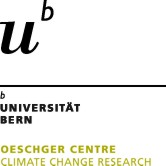The role former tavern "Krone" plays in climate research
The historian Oliver Wetter breaks the mould. He not only tracks down unusual sources, but he also uses scientific methods to validate them.

For once, Oliver Wetter did not search Basel's public record office purposefully for specific files, but strolled through the archives, letting curiosity lead the way. A dissertation analysing historic hospital bills caught his eye. When the young climate historian flicked through the pages, it dawned on him that these so-called Basel hospital accounts represented a mine of climate information.
That is, if you are able to think laterally. Hospital administrators in the 15th and 16th century did not really note down weather observations, but they meticulously recorded revenues and expenses. If like Wetter you are familiar with the historic context, you would know that the Basel hospitals owned large estates that required day labourers during the harvest season. So, the day, hospital accountants for the first time recorded expenses for day labourers, represented the beginning of the harvest time. Wetter compared these entries year by year to track the climate over the centuries and then used statistical methods to reconstruct past temperatures based on his findings. For a city like Basel, where the temperature has been recorded since 1755, the clever trick was to look at more recent measured data to draw conclusions about temperatures at times before the invention of the thermometer. By combining the measured values for the beginning of the harvest season with the historic records, Wetter was able to convert indirect information into quantitative climate data. Climate researchers call this equation technique calibration.
Accounts acting as climate archives

In other words, the Basel hospital accounts from 1454 to 1705, which Wetter used, represent a valuable climate archive – comparable with natural archives such as tree rings or ice cores, but a lot more precise with regard to timelines. The Basel archives offer a wealth of such sources. They are unique worldwide because, unlike other important archives that were repeatedly destroyed during the wars, these files have been preserved unscathed since Basel's devastating earthquake in 1356.
In addition to temperature reconstructions, Wetter also studied the historic Rhine floods in his dissertation. His goal was to make a quantitative comparison of the flood disasters in pre-instrumental times with those after 1808, when Basel obtained its first hydrological measurements.
Unlike remodelling historic temperatures, reconstructing floods was relatively easy, because Wetter was able to draw from a wealth of historic sources, ranging from records by medieval annalists to paintings and newspaper articles from the 19th century. Instrumental to the work of the historian was the fact that Basel developed almost a tradition of describing floods because the chroniclers always referred to the same markers.
Historical sources and hydrological models

One of these more than a dozen reference points identified by the historian is the corner of the Gasthaus Krone, a hotel located directly opposite Schifflaende, the Basel shipping pier. This reference has been used in comparative descriptions over the centuries: In 1506, the flood reached "into the tavern," in 1664, it reached "the front door" and in 1764, the flood "didn't quite reach the corner of the tavern." Fortunately, local journalists referred to the "Kroneneck" when writing an article on a flood well into the 19th century, when the Rhein's water levels and effluent were measured with instruments. The parallel use of the two recording systems allowed Wetter to convert the descriptions into numeric values, and he eventually managed to compile an unprecedented data volume: the reconstruction of flood occurrences over 743 years.
One of the side benefits of Wetter's hydrological model is that it also provides climate historians with quantitative data on the volumes of water. Thus, researchers may for the first time directly compare the floods from pre-instrumental and instrumental times. These research findings are not only of scientific interest. Insurance companies for example, who calculate premiums based on so-called once-in-a-century events, are very interested in comparative data that reaches that far back. Only an analysis of flood disasters over the centuries, allows researchers to judge whether the incidence has indeed increased over the past decades. These questions are, of course, also pertinent to current discussions about the safety of Swiss nuclear power plants.
Wetter himself is more than happy with his results. "First, I was simply fascinated that my work could contribute to a better understanding of climate change. Today, I'm not just fascinated, but I am also aware of the incredible potential of historic climatology. And, at this point, we're only at the very beginning of all analyses that are possible."
(2011)
